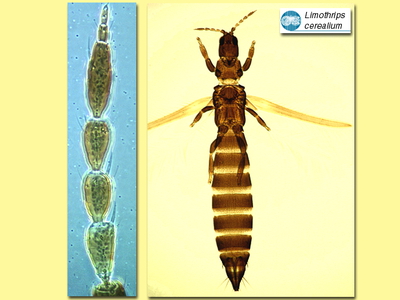Figures
Fig. 1 Antenna, head, thorax and abdomen
Fig. 2 Head (dorsal)
Fig. 3 Pronotum
Fig. 4 Fore and hind wing
Fig. 5 Meso- and metanotum
Fig. 6 Tergite X (female)
Species
Limothrips cerealium Haliday
Biology
Breeding in the flowers and on the leaves of many grasses and temperate cereal crops, this species sometimes occurs in vast numbers, and is well known in western Europe for its habit of crawling into confined spaces and thus causing smoke detectors to activate fire alarms.
Distribution
Widespread around the temperate areas of the world on wheat and barley crops.
Recognition
Large dark brown species with deeply shaded forewings. Antennae 8-segmented, sense cones on III & IV simple; segment III slightly asymmetric. Head elongate and prolonged in front of eyes. Pronotum with one pair of long posteroangular setae. Metanotum with weak reticulate sculpture, median setae small and not close to anterior margin. Forewing slender, setal row on first vein widely interrupted. Tergite X with a pair of large thorn-like setae. Sternites with transverse row of small discal setae. Male wingless, pronotal setae often short; tergite IX with pair of tubercles each bearing a small stout seta; sternites III-VII with an oval glandular area.
Related species
About five species are recognised in this genus, the two most common of which have either the second or the third antennal segment strongly asymmetric.







